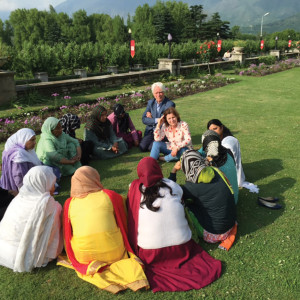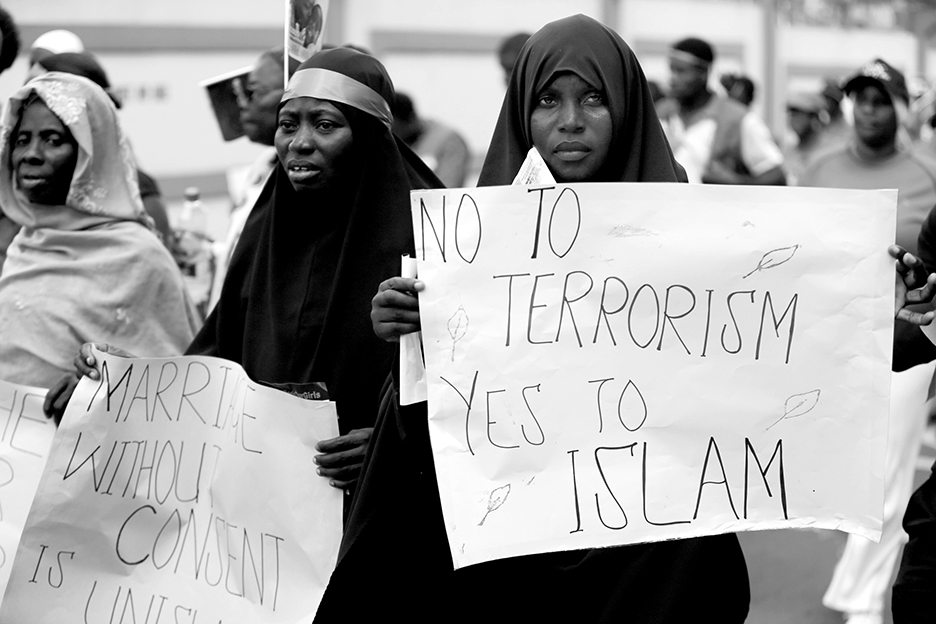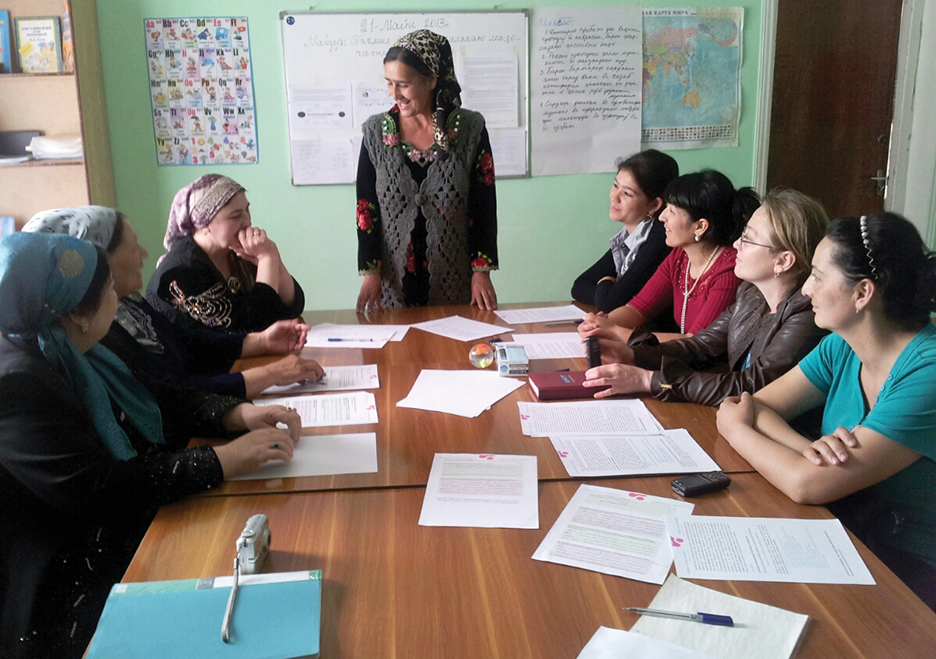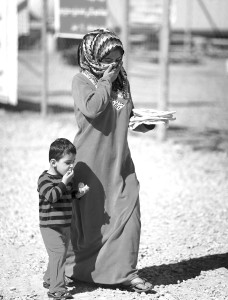Families are best placed to address radicalization before it escalates into violence
By Dr. Edit Schlaffer and Dr. Ulrich Kropiunigg, Women without Borders/SAVE
Radicalization is a process that often takes place at home under the noses of parents and close family members. Parents are often unaware of what is going on with their adolescent or young adult child until it is too late.
When a son or daughter “changes,” it isn’t necessarily a warning sign. Adolescence is a time of change. Parents sometimes feel secure and relieved when their child turns away from drugs and embraces Islam instead. From then on, there is no smoking, no drinking, no sleeping until noon. Other parents may ponder the seriousness of certain behavior patterns but assess them as harmless and within the undefined borders of adolescent “storm and stress,” as one mother of a foreign fighter put it. She was concerned and torn between tolerance and helplessness. “He wouldn’t talk with me as much as he used to. He stopped seeing his friends and spent more and more time in his room.” These were warning signs, but they were overlooked until the son went to Syria and soon after was killed.
What were the driving forces in his case? What pushed and pulled him away from his family? Interestingly, in general terms, we are much more informed about pull factors and recruiting methods than the deep dynamics that cause a child to turn radical in the first place. A clue might lie in what a Belgian mother was involuntarily forced to observe: “The recruiters gave him a sense of personal value that he didn’t have in his life. This is what brought him to Syria.”

Mothers Are Neglected
Experts have studied the underlying social and psychological factors that motivate individuals to adopt extremist ideologies, yet comprehensive conclusions have not translated into policies. The counterterrorism approach has largely consisted of reactive strategies, relying heavily on military and security forces to carry out actions meant to punish and deter. While this strategy has recently been scaled up, the incidence of terrorism is growing more critical. Theoretically, we know push and pull factors and many other root causes, but these theories have not been applied on a practical preventive level. One reason is that countering violent extremism (CVE) research has left out a key actor: mothers.
As a group, mothers hold valuable data on what makes individuals vulnerable to radical influences regardless of economic, political and socio-economic factors. In particular, mothers of radicalized youth view their children’s coming-of-age journey as navigating the uncertainty of adolescence and young adulthood, and as a result, provide unique insights into responses incomprehensible to outsiders. Furthermore, mothers are also strategically placed to serve as a buffer between radical influences and those targeted next. They are the starting point for building resiliency within their children’s early years of development, as well as the first to recognize and address signs of distress such as anger, anxiety and withdrawal. This dual capacity to pre-empt and respond to radical influences makes mothers essential participants in an effective security paradigm.
It is widely recognized that individuals are influenced by their social contexts: their hopes, aspirations, struggles and reactions are largely shaped by the environment in which they emotionally and psychologically develop. In examining these social and emotional variables, we can gain a clear picture of the common factors that lead people to adopt extremist ideologies, and therefore develop targeted prevention strategies. “If we really want to identify and support resilience in communities under threat, we cannot do so from a distance. We need to listen to and observe its residents and learn about its history, culture, social structure, values, needs, resources, and daily experiences, in order to determine precisely what resilience means for them,” notes the article “Building Community Resilience to Counter Violent Extremism” published in Democracy and Security in 2013.
A New Research Model
Based on this understanding of the deficits of ongoing CVE approaches, and of the unique position of mothers, the nongovernmental organization Women without Borders/Sisters Against Violent Extremism (SAVE) developed an applied research project to collect evidence on mothers’ potential to protect at-risk youth. The organization’s “Can Mothers Challenge Extremism” study examined mothers’ perception of the threat of violent extremism and their understanding of their role in the radicalization and deradicalization process. The study draws on the subjective understanding of mothers on the causes, factors and realities of violent extremism as they experience them in their families, communities and, most importantly, in the lives of their children. The study focused on sons because, while daughters are increasingly joining extremist groups, boys remain the majority of those involved.

The Study
The three-stage study was designed to collect, analyze and apply data from mothers living in Nigeria, Pakistan, Northern Ireland, Israel and Palestine — regions affected by violent extremism. In the first stage, 200 in-depth interviews were conducted in each country to gain an overall picture of the social and emotional environments of adolescent and young adult sons. The questions were grouped into seven areas: family background, the children’s lives, the mother’s role in her child’s upbringing, proximity to extremism, societal factors — especially in contexts affected by violence, existing coping mechanisms for violent extremism individually and collectively — and future strategies.
In many communities, extremism and violence are taboo; therefore, gathering data requires breaking through social barriers. Some women were reluctant to talk at first, particularly mothers whose children were already involved in extremist activities. Guilt, shame and fear initially inhibited them. They eventually opened up once they understood that they are valuable contributors and allies. Many subjects expressed relief after speaking out. From these interviews a number of themes emerged, and these were used to develop a questionnaire. Three key areas were explored: 1) how mothers see their role in reducing the attraction of extremist ideologies, 2) who they would turn to in a situation characterized by confusion, fear and alarm, and 3) what they need to be effective in recognizing and responding to the warning signs of radicalization.
The interviewing team focused on over 1,000 respondents — about 200 in each country — to complete the questionnaire. The questionnaire used a Likert scale to assess levels of agreement with 43 statements and questions. Another three topics addressed were: 1) What are the sources of extremist influences? 2) Whom do mothers trust? 3) What do mothers need?
Study Results
Overall, a consensus emerged regarding perceptions of a mother’s role in countering extremist influences. The data from both the interviews and the surveys strongly conveyed mothers’ concerns about the risk of their children becoming radicalized. A majority of mothers expressed confidence in their own abilities to prevent their children from becoming involved with violent extremism in the first place and to recognize early warning signs. Moreover, in many of the interviews, the mothers expressed a sense of urgency and eagerness to collaborate with similarly concerned mothers in combating the growing problem of extremist recruitment.
A Mother’s Fear
The mothers believe that extremist agendas are disseminated primarily through the Internet, radical religious leaders, political organizations and television. These sources are not surprising, but the overall picture that emerges is noteworthy. These four diverse sources are given almost equal significance, indicating that on an average day, youth are confronted by radical messages from many different angles: the media, the Internet, schools and social networks. The breadth of these sources indicates that some communities have very little protected space, leaving youth highly vulnerable. Therefore, the pervasiveness of extremist messages, reported by the mothers in the study, provides strong support for a security approach that focuses on building resiliency within and around the home.
Moreover, this data is particularly important because this information — collected within a private realm — is largely inaccessible to local authorities, intelligence and other actors involved in terror research. From their unique position, these mothers’ perspectives on the initial source of extremist influence is likely to be the most accurate. As researchers and policymakers have widely acknowledged, gaining a clear picture of the initial entry into extremism has important implications for effectively addressing radicalization at its origin. Mothers’ insights help to elucidate the most intricate details of this picture.

A Mother’s Trust
Where do mothers turn when they have concerns about their children’s safety and well-being? What people or institutions do they trust to provide support? The primary answer was other mothers, at 94 percent. Fathers were listed next, at 91 percent, followed by other relatives, at 81 percent. In a crisis, the family circle is the primary source of support. Teachers, listed fourth with a trust score of 79 percent, and community organizations, at 61 percent, are the first institutions they turn to outside of immediate social networks. Religious leaders earn a 58 percent trust score, suggesting a level of some ambivalence. State organizations earn among the weakest trust scores, with police at 39 percent, the army with 35 percent, and local government with 34 percent. International organizations earn similarly weak trust scores of 36 percent. The national government, however, earned the lowest trust score overall: 29 percent.
The most important piece of data, corroborated by other evidence in the study, is that mothers trust themselves along with other mothers first in protecting their children. This is notable because the existing security approach currently focuses implementation within national and local authorities, two groups that seem to evoke significant distrust. Moreover, the lack of trust in the state is a critical finding and reveals a trust gap between the private and the public spheres as they relate to security. This fundamental problem was recently addressed in a 2014 Terrorism and Political Violence article titled “The Stagnation in Terrorism Research,” which argues that government and private citizens need to collaborate to combat radicalization. Therefore, a key step in countering terrorism is finding ways to enable cohesion and trust within communities. This is a finding that was likely only to come from mothers themselves.
What Do Mothers Need?
How then do mothers assess their own needs? What kind of support do they need to protect their children from radicalism? First, the data indicate strong radicalization concerns. This emerged during our interviews and during the survey. Of all needs provided in the survey, 86 percent of mothers considered increasing their knowledge about the warning signs of radicalization to be of highest importance. This was followed by training in self-confidence, parenting skills and computer skills. Moreover, a majority of mothers favored connecting with similarly concerned mothers and speaking up together against radicalization.
This reveals two important conclusions. The first is that mothers are confident in their own security potential if equipped with the right tools and knowledge. Second, their awareness of their needs indicates they are already confronting radical influences and feel as if they are responding less than effectively.
Overall, these findings suggest that there is an immediate need for a more diversified approach to counterterrorism — namely one that includes the expertise and strategic position of mothers. In a preventive paradigm, their voices and capacities are essential to develop new strategies and partnerships. But this requires mothers to be recognized as key allies; as long as they are excluded, so is this most valuable point of intervention. The gap in the existing security paradigm, seeking to address recruitment at the root, requires the involvement and active engagement of mothers.
The Mothers School Model
In the wake of these significant conclusions, the final stage of the “Can Mothers Challenge Extremism” study applied the acquired knowledge and developed a comprehensive model that addressed the most important needs expressed by the mothers. Specifically, the findings indicated that mothers hold significant, underrecognized potential in countering violent extremism, yet needed specific support to optimize their capacities. With this data, Women without Borders created the Mothers School (MS) model to address these needs and strengthen community resilience, starting at the center of the home.
The MS model seeks out mothers as an embedded security ally and arms them with the skills to be an effective foundation of community resilience. This model targets and optimizes a pre-existing, underutilized resource and is inherently a grass-roots approach. The curriculum, implemented through trusted community partners, includes specific exercises that facilitate dialogue, exchange information and use critical reflection through context-based techniques that apply to participants’ daily lives. This model creates a formalized space for mothers to improve their knowledge of early-warning signs and strategize how to be effective barriers to radical influences. Together they can deconstruct social barriers and have open dialogue about their children’s struggles, as well as their own.
MS has been a pilot project in Indonesia, Kashmir, Nigeria, Pakistan, Tajikistan and Zanzibar, and evaluations show that it has been embraced. Mothers report that participating in MS with similarly concerned women builds self-confidence, improves parenting skills and provides them more credibility in their homes and communities. As one MS participant from Kashmir stated: “We always think that such discussions can only be among the educated and elite people from high profile societies. But, now we believe after exploring, our skills were with us always but unfortunately on sleeping mode, that we can also become friends with our children and help them to deal with any kind of support so that they don’t feel the need to look for any violent alternatives.” The pilot findings also indicate that the MS curriculum provided the mothers with substantive information and targeted skills, better preparing them to identify and respond to radical influences.

The MS Curriculum
The central components of the curriculum are building confidence and self-esteem, increasing knowledge and reflection on parent-child dynamics, and delivering specific training in countering radicalization. The curriculum includes 10 modules spanning three stages, guiding participants through a process of gradual awareness-building. These stages move successively from the self, to the family, to the community, and then to one’s role in security.
The first four workshops aim to collectively create a safe and comfortable environment in which barriers can be deconstructed and productive dialogue can take place. The exercises guide them through critical reflection on themselves, including identifying their strengths and weaknesses, along with analyses of their communities and their roles within them.
Feedback from MS participants suggests that the workshops are meeting these needs. As one mother stated: “Once you encourage someone here who shares her sad story or about the problems in their lives, just a word of encouragement makes them feel strong. They think they are not alone. They get the feeling of acceptance.”
The crucial adolescent phase is a small window of opportunity for two key actors. Radical recruiters appeal to disaffected youth at this time of heightened vulnerability with promises of honor, community and paradise. But it is also a pivotal point for mothers to instill counternarratives and positive alternatives. The next stage progresses from addressing barriers to emphasizing targeted skill training. Primarily, it aims to address the need of improving parenting skills and focuses on education and analysis grounded both in theory and on the social political realities of the community.
For example, one mother explains how she applied this knowledge in her home: “It is a common belief that you don’t give much importance to the children and listen to them every time, and instead you should be strict so that a fear is maintained and they have respect. But, in this class, I came to know that the fact is something else. … It is just a notion and it is very important to acknowledge the problems of our children.” Another mother asserted, “Instead of making the problems an excuse, we should also develop positive thinking so that our children don’t feel burdened and depression due to us.”
The last stage focuses on how to establish and continually reinforce resilience in the home. Mothers are provided with specific instruction on recognizing and reacting to the early warning signs of radicalization, including instruction on the role the Internet plays in spreading extremist messages, as well as how to engage fathers in looking out for, and addressing concerning behavior. At the conclusion of this stage, the mothers have an increased awareness of the threat of radicalization to their children, and a deepened understanding of their own role, as well as a broad tool kit of strategies.
Moving Forward
As the study findings convey, mothers are instrumental in implementing targeted intervention at the previolence phase. And they are a valuable source of information, not only about the intricacies of youths’ social and emotional environment, but also as a reflective lens. Mothers of radicalized youth provide a perspective most salient to developing a new security approach. Mothers are the common thread to youth who vary in background, religion and political involvement. As the emotional link to their children, they have the unique ability to piece together common denominators.
To give prominence to this key data, Women without Borders brought a group of mothers from Europe and Canada to share their insights about the radicalization process of their children, who had all departed for Syria. In sharing their experiences with security stakeholders in a strategy meeting, they painted a picture of their children’s personalities, struggles and the changes observed in the early stages of the radicalization process. As one mother whose son died in Syria in 2012 explained: Recruiters “mislead children because it tells them they are selected, that they are chosen. These ideas tell them that Allah will take care of them.” Another mother shared: “My son was very immature. He had no real information about religion and no real intellectual perspective about religious questions. This is why he was radicalized so quickly.” These mothers were able to present to government officials, policymakers, counselors, educators and journalists how their children were lured away and what, in hindsight, were the warning signs.
For example, one mother noted: “Having a bottle of wine at dinner suddenly became a problem. Then we couldn’t have friends over because he was afraid of how they would dress.” Another mother said of her daughter, “She hid the voting card when it came in the mail. She started denouncing democracy.” These signs, in retrospect, are clear indicators of their children’s new influences, but the mothers explained how fear, confusion and even false hope prevented them at the time from understanding their gravity. Most importantly, the mothers felt they lacked support that could have helped save their children. “I hid my concerns from everyone. … I was too afraid to talk. … If I had known where to turn, maybe I could have stopped him.” Another mother shared how authorities failed to take her concerns seriously when she tried to warn them that her daughter was trying to leave for Syria: “In France, the authorities don’t have connection with the parents. They don’t have the will; so we all work for the same goals in different spheres and don’t make any progress.” Indeed, clearly defined solutions evolved out of this conference, including improved communication and collaboration between local authorities and families, and scaling-up of counseling services and counseling referral mechanisms. These strategies are likely to be among the most effective as well as cost-efficient.
The conference’s positive feedback from the mothers and the government and community representatives supports the need to explore ways to formally include mothers’ insights into security dialogues. Security stakeholders not only found this conference uniquely informative, but the mothers returned to their homes inspired and equipped to help other at-risk families.
The Next Step
In establishing a robust security architecture, closing the information gap is the first step. This is accomplished in large part by including mothers’ insights in the preradicalization phase, followed by the development of prevention strategies that address these early concerns, and the use of mothers as the primary implementers. Enabling mothers through capacity-building is a key element in this bottom-up approach. However, for these initial fortifications to have an impact on curbing violent extremism, mothers must have support within civil society.
Conclusions
Mothers sit on the front line. We would argue that their position is even more vital than that of local authorities who are tasked with reacting to, rather than pre-empting, processes of radicalization. So, in the absence of our ability as a global society to eliminate the myriad causes and sources of radical messages, our only option is to build resiliency from within. Addressing the internal, emotional forces that leave one vulnerable to extremist ideologies, such as anger, resentment, resignation, or lack of purpose and belonging, requires individual attention and support from trusted, willing individuals. Violent extremism, understood as a symptom of these emotional deficits, is inherently beyond the scope of the government or local authorities. In fact, it demands the involvement of civil society.
Mothers are at the center of the home; they are the first to recognize changes in their children, such as anger, anxiety and isolation. They have unique access and a continuous connection with their children, which remains consistent throughout their growing interactions with the outside world. They are a crucial element to building resilience into the social fabric. Indeed, tapping into mothers’ preventive potential and establishing capacity-building mechanisms for mothers as key security allies is an essential part of an effective and cost-efficient security architecture. This is a tall order and deserves recognition and support. Overall, it is not only the mothers, but the world at large that stands to gain the most from this effort.


Comments are closed.